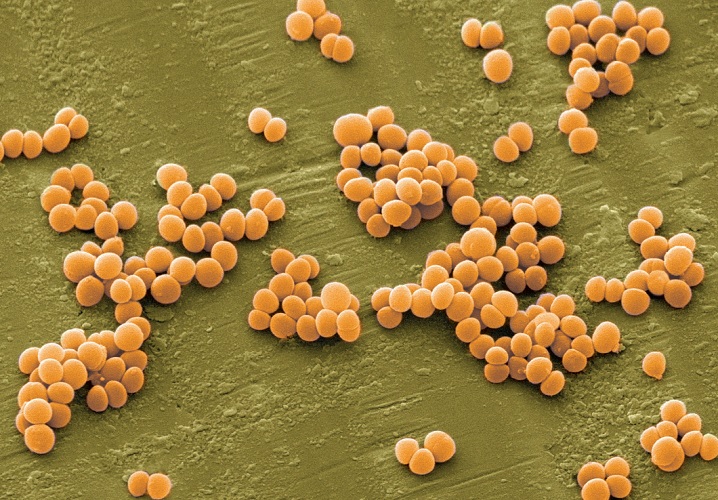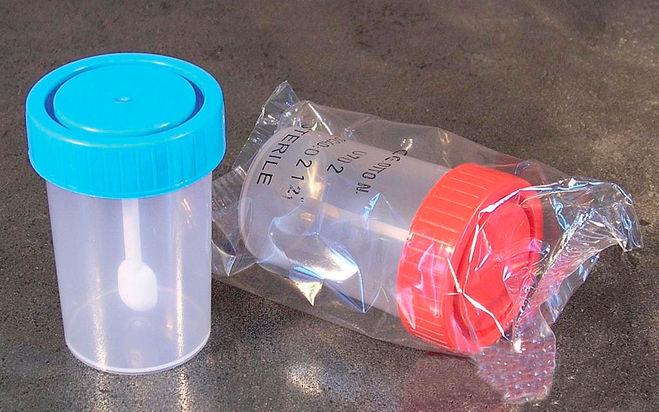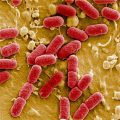- What is Staphylococcus aureus
- Signs and symptoms of infection
- Staphylococcus aureus in the gut
- symptoms
- Treatment
- Staphylococcus aureus in the nose
- symptoms
- Treatment
- Staphylococcus aureus in the throat
- symptoms
- Treatment
- diagnosis of the disease
- What tests need to take
- Decoding results
- How to cure Staphylococcus aureus
- How dangerous Staphylococcus aureus
- disease prevention
Staphylococcus aureus - a very common and dangerous bacteria, which can cause and trigger a variety of serious diseases. Aureus carriers are a little less than ¼ of the world's population. But, Despite this prevalence, in terms of the treatment of this disease is extremely complex due to the bacteria's ability to easily mutate and develop resistance to all drugs.

What is Staphylococcus aureus
In its origin Staphylococcus aureus is a bacterium, which in view of (pictured under a microscope) It resembles a bunch of grapes, ie. It consists of several golden colored balls. The bacterium is aerobic specifics (ie there may be in the air), so that is quite widespread in the environment: it can be on toys, the subjects of the environment, medical instruments, in breast milk, in the affected areas of the mucous and human skin.
The source of origin of the infection becomes infected person, which carrier itself for a long time may not be aware of the presence in the body of dangerous bacteria. Normally, the bacterium Staphylococcus aureus is present in the body of most people. But in healthy people with strong immune microflora inhibits staph, not letting him prove himself.
Important! Staphylococcus aureus is activated in the body due to lower immunity or a sharp deterioration in general condition.
causes, provocative activity of staphylococcal infection, can be:
- chronic diseases;
- Interaction with bacteria carrier (by droplets, through the damaged skin or mucosa);
- The sharp decrease in immunity (due to stress, antibiotics or hormonal drugs, beriberi, malnutrition, etc.);
- The use of insufficiently processed foods, infected by the bacterium;
- Failure to comply with hygiene and health standards in skin lesions (abrasions, scratch, cuts);
- intestinal dysbiosis.
Children infected with Staphylococcus aureus occurs frequently in hospitals, aided by a number of factors:
- Immaturity (prematurity) child;
- pathologies, related pregnancy;
- Malnutrition in the newborn;
- bottle-feeding;
- Failure to comply with the rules of personal hygiene.
Most often, the infection by Staphylococcus aureus occurs in hospitals (especially in hospitals), where there is a high concentration of microorganism in the environment, and which violated the rules of instruments sterilization and antisepsis.
note! The bacterium can be found everywhere: on the nose, on the skin, throat, in the gut, and even on the genitals. This "omnipresence" of the microorganism affects the amount of diseases, which can cause Staphylococcus aureus.
The biggest danger of Staphylococcus aureus - the amazing vitality of bacteria. At its activity does not affect the cold, our moisture (or her absence), no direct sunlight. This ability makes the infection intractable and resistant to various drugs.
Signs and symptoms of infection
Manifestations depend on the S. aureus bacteria localization and state of the body's defenses.
note! The main signs of infection present - high body temperature, symptoms of intoxication (lethargy, lack of appetite, weakness, drowsiness, nausea).
The bacterium Staphylococcus aureus can cause a person defeat of various organs and systems, resulting in peritonitis may occur, abscesses, appendicitis, dermatitis, pyoderma, gïdradenïtı, holetsystytы, pneumonia, eczema, etc.. This is not the whole list of diseases, which could trigger a dangerous microbe.
Consider, as Staphylococcus aureus may occur, depending on the site of virus infection:
- Digestive tract. Once in the intestines of food or drink, infected with bacteria, begin to show signs of food toxicity: vomiting, diarrhea, severe abdominal pain, mouth dryness, nausea.
- Lungs. develop pneumonia (more often - in young children), characterized by the emergence of short-term fever, followed by respiratory failure, then you may experience symptoms of obstruction.
- skin. Symptoms depend on the area of injury and infection manifested occurrence of boils, abscesses, karbunkulov, phlegmon. The process is accompanied by fever, general weakness.
- Eyes. Develop symptoms of conjunctivitis: lacrimation, photophobia, swelling of the eyelids, pustular discharge from the eyes.
- An ear, nose, throat. Most often Staphylococcus aureus growing in the nose or throat, causing rhinitis, sore throat, sinusitis, pharyngitis, tracheitis. In severe forms of infection bacterium affects the ear canals, causing otitis.
- central nervous system. Getting an infection in the brain triggers the occurrence of meningitis, as well as brain abscess. The disease occurs in severe high temperature, severe headaches, vomiting.
- urinary tract. Staphylococcus aureus causes cystitis, urethritis, pyelonephritis. symptoms: temperature rise, pain in the lumbar region, painful and frequent urination.

The most frequent complications of Staphylococcus aureus include the following states:
- staphylococcal scalded skin syndrome (It is more common in infants and young children). Symptoms are similar in presentation to scarlet fever or erysipelas: rash or more foci of inflammation of the skin.
- bacterial endocarditis (observed in people with very weak immune systems, addicts, alcoholics). symptoms: fever, sweating, chills, temperature rise, symptoms of intoxication.
- toxic shock. Characterized by the sudden appearance of elevated temperature, headaches, pressure reduction, vomiting, palpitations. The body rash, after - there is peeling of the skin.
Symptoms Staphylococcus aureus directly depend on the introduction of a microorganism place, the immune system and the aggressiveness of the pathogen. Because the treatment of infections will be assigned depending on the place of dislocation bacteria.
Staphylococcus aureus in the gut
The presence of bacteria in the intestine and its active multiplication there is a serious condition due to the release of Staphylococcus aureus entertoksinov. These include:
- Enterokolit enterit. Characterized by a gradual increase in symptoms. Prior manifestations of intestinal mucosal inflammation usually occurs the upper airways, because the disease is often confused with acute respiratory disease, or SARS. symptoms: slight fever, slight indisposition, more frequent stools (to 8 times per day).
- Toksikoinfektsiya. It runs hard, symptoms of severe food poisoning recalls.
symptoms
The incubation period after getting an infection in the intestine does not exceed 5-6 hours, so the symptoms of infection can be recognized immediately.
Staphylococcus aureus in the intestines manifested by the following symptoms:
- Violations in digestion: frequent (to 12 times a day) chair, in the stool may be observed streaks of blood and mucus.
- Cutting pains in the abdomen, without clear localization.
- Severe vomiting and nausea, manifested regardless of the meal;
- Possible allergic skin rashes;
- A feeling of weakness and fatigue;
- slight fever (to 37-37,5 degrees).
Staphylococcus aureus rapidly multiplies in foods. The most common infection of the microbe is exposed to dairy products, eggs, salads, cakes, cakes, fresh meat.
Treatment
In the treatment of Staphylococcus aureus in the intestine are frequently used antibiotics: vancomycin, Kubica, Ceftobiprole, linezolid. But antibiotics disrupt the intestinal microflora, causing dysbiosis, thereby creating favorable conditions for bacterial growth and development. So often the physician assigns patients staphylococcal bacteriophage, which is the most sensitive method for treating an infection in the intestine.
At the same time it is recommended to take immunomodulators, vitamins and comply with sparing diet.

Staphylococcus aureus in the nose
The reason for the emergence and propagation of bacteria in the nose - low immunity, arose against the background of viral infection. These infections can be: herpes virus, immunodeficiency virus (SPID), all respiratory viruses.
symptoms
The main feature of the action of Staphylococcus aureus in the nose - purulent inflammation, which is characterized by the following symptoms:
- Heat (38,5-39 degrees, and higher);
- Nasal congestion;
- Nasal discharge purulent;
- cold;
- Headache;
- Purulent accumulations in the paranasal sinuses;
- Pain in the forehead and sinuses.
The infection may well spread further - in the region of the pharynx, into the cavity of the middle ear. Symptoms will appear accordingly with the localization of bacteria.
note! aurococcus, develop on the background of chronic sinusitis, It causes severe exacerbations.
Treatment
Simultaneously with the standard diagnostic measures in patients taking crop from the nose to detect the pathogen. But such analysis is done a few days, so it is usually to identify the results are usually prescribed antibacterial treatment.
Important! Treat Staphylococcus aureus in the nose should be only in case of acute manifestations: high temperature and purulent secretions.
medication:
- antibiotics (Flemoclav, Amoksiklav);
- bacteriophage Streptokokkovый (instilled into the nose);
- vitamins;
- Preparation IRS-19;
- antihistamines.
In parallel, local procedures: nasal lavage, vasoconstrictive drops instillation solution and chlorophyllipt.

Staphylococcus aureus in the throat
Staphylococcus aureus causes a purulent inflammation of the throat: angina, sinusitis and rhinitis with purulent discharge, pharyngitis, otitis, tonsillitis and other. The main reason for switching bacteria in infectious disease - the weakening of immunity, reasons which may be:
- Long-term chronic diseases;
- Acute respiratory infections;
- herpes virus;
- Immunnodefitsitnye state.
In adults, weakened immunity may arise against the abuse of tobacco and alcohol, frequent stress, sedentary lifestyle.
symptoms
Staphylococcus aureus in the throat appears similar to common cold symptoms:
- Scratchy and sore throat;
- A burning sensation in the throat;
- slight cough.
These symptoms may increase for a few hours (or more days), after which the clinical picture becomes more pronounced.
Important! Main symptoms of Staphylococcus aureus in the throat - the emergence suppurations, fever and cough.
Since Staphylococcus aureus is essentially a purulent infection, his appearance accompanied by the appearance of pustules on the throat and boils as well as inflammation of the tonsils. Purulent processes are accompanied by the temperature increase required.
Treatment
Before, how to treat Staphylococcus aureus in the throat, via throat swab investigated throat flora. This procedure allows to identify the type of bacteria and pick her an antibiotic.
Throat infection treatment includes:
- Admission immunomodulators general and local action (IRS-19, Imudon);
- Local antibiotic therapy (Miramistin, Bioparoks) and general (Cefriakson, azithromycin) actions.
should not be overused antibiotics in the treatment of Staphylococcus throat, tk. these drugs are aggressive towards the mucosa. If possible, conduct treatment with staphylococcal bacteriophage, which is used in the form of rinse.

diagnosis of the disease
aureus, treatment should begin after the special diagnostic procedures, which include the analysis and antibiogram.
What tests need to take
List of the necessary assay is based on the research environment, which could settle the bacterium:
- Blood test. Reveals the presence of staphylococci, neutrocytosis, leukocytosis, increased erythrocyte sedimentation rate. Before the study should stop taking any antiviral drugs for three days.
- Analysis of urine. It identifies the number of leukocytes and Staphylococci.
- analysis of feces. Sowing is taken for the study of culture medium, Analysis is carried out not later, than 3 hours after the defecation. Thus detected aureus and its sensitivity to antibiotics.
- Smears with mucous. Analyzes take, depending on the localization bacteria: from mouth, lower eyelid, nasopharyngeal. NP swab is taken on an empty stomach, and mouth, before toothbrushing, before meals and medication. With the lower eyelid is scraped from the bottom century before washing.
- Smear skin. Scraping conducted with sections of damaged skin, pre-treating the wound site antiseptic.
All of these diagnostic measures are conducted in order to identify specific infectious diseases, caused by staphylococcus. Research helps identify the specific type of bacteria, the degree of infection by Staphylococcus aureus, and sensitivity to various antibiotics influence.

Decoding results
Staphylococcus aureus is determined by the following indicators in the feces:
- If CFU indicators < 1*104 (norm) , prescribe vitamins and immunomodulators, tk. the risk of complications at these rates is minimal.
- If CFU indicators < 10*104, selected antibiotic (on the basis of other additional diagnostic procedures).
- If something > 100*104, it speaks about the possible development of sepsis, and therefore, the treatment required massive therapy (possibly, in the intensive care unit).
Detection of Staphylococcus aureus is confirmed by the results of blood and urine tests: elevated erythrocyte sedimentation rate, reduction of total protein, an increase in white blood cells.
Smears on the flora (of mucous, skin, et al.) and feces sowing allow to make antibiotikogrammy.
note! Antibiotikogrammy - drawing up a list of antimicrobials (antibiotics), in which the sensitivity of bacteria detected, found in the analysis of.
Drafting antibiotikogrammy allows you to assign adequate treatment and to choose the right drugs.
How to cure Staphylococcus aureus
Mild forms of Staphylococcus aureus do not require antibiotics, in other cases, the use of antimicrobial drugs is usually unavoidable.
therapies:
- antibiotic therapy. The most frequently prescribed drugs penicillin (oxacillin, ampicillin), a combination of penicillin and clavulanic acid (Amoksiklav), tsefalosporinы (ceftriaxone, Kefzol).
- bacteriophage staphylococcal. Such a treatment is given in case of impossibility or ineffectiveness of antibiotic therapy. The bacteriophage is a virus bacteria, acting on pathogenic organisms, it does not destroy the intestinal microflora and has no side effects and contraindications.
- Preparations local impact: hlorofillipt - for the treatment of throat, nose and throat; ordinary "Zelenka" (or a solution of brilliant green), hydrogen peroxide, antibacterial ointment - with chronic inflammatory skin diseases; weak solution of potassium permanganate and Albucidum - conjunctivitis.
- Means to enhance immunity: artificial immunomodulators (immunoglobulins), herbal adaptogens (eleuterokokk, ginseng), polyvitamins. To enhance immunity, the patient should drink plenty of liquids, and the observance of a balanced diet, enriched with vitamins and minerals.
Methods of treatment are chosen depending on the degree of injury of various organs and localization of bacteria.
note! Staphylococcus aureus can be cured, but the process is complicated by the, that the bacterium can develop resistance to antibiotics.
When the antibacterial rate must pass it completely, tk. if abruptly stop taking antibiotics, Staphylococcus aureus is not die, and acquire immunity to use the drug.

How dangerous Staphylococcus aureus
The main danger is staphylococcus, that the bacterium has extraordinary survival, and with the weakening of immunity can cause a variety of serious conditions, until blood poisoning, coma, sepsis and infectious-toxic shock.
Highly pathogenic bacteria due to the following features:
- Staphylococcus aureus has increased resistance to environmental factors and antiseptics - withstands freezing, boiling, alcohol treatment, etc..
- Bacterium capable of producing specific enzymes and ligase penicillinase, that make it resistant to certain types of antibiotics.
- Staphylococcus aureus produces endotoxins, leading to the general intoxication.
The bacterium is difficult to treat - antibacterial drugs for the treatment of Staphylococcus aureus is hard to find, and immunity to the bacteria do not produce, and the disease may come back.
disease prevention
Despite, that severe forms of S. aureus are rare, the disease is very common. Because not take the basic rules of prevention, to avoid infection:
- To wash hands, personal hygiene.
- eat balanced, paying particular attention to the presence of vitamins and minerals in food.
- Do not comb your wounds and skin rash.
- Periodically guzzle a course of vitamins.
- Do not use other people's hygiene products.
- Strengthen the immune system of sports and hardening.
- Observe the thermal processing of food products, drink clean water.
When lung lesions Staphylococcus aureus disease prognosis is favorable. but, This does not mean, that it is necessary to delay treatment and lightly to the emergence of infections.












